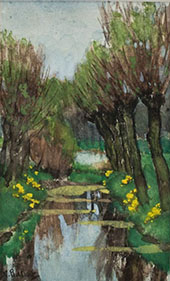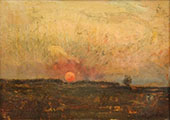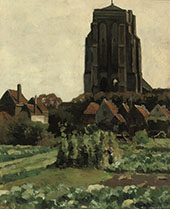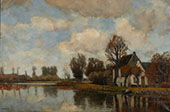Hague School Oil Painting Reproductions
Find Hague School oil painting replicas by Hague School artists
The Hague School of Dutch Painting: A Brief Introduction
The Hague School produced some of the most beautiful Dutch paintings of the nineteenth century. As the name suggests, this group of painters worked in the Hague area of the Netherlands. Their artworks are painted in muted and subdued colors, creating subtle impressions and wonderfully atmospheric scenes. Its members include Jozef Israels, Anton Mauve, Jacob Maris, and Johannes Bosboom; these artists transformed Dutch oil painting.
This brief introduction explores the Hague School artists and their most famous oil paintings.
When was the Hague School founded?
The School came together around 1860. A group of young artists, including Jacob Maris, Gerard Bilders, and Anton Mauve, started painting the forests around Oosterbeek, a village in the eastern part of the Netherlands. Inspired by the French Barbizon School painters who also painted woodland countryside near Fontainebleau, these Dutch artists looked to emulate their success.
Taking inspiration from the paintings by Jean-Francois Millet and the Landscape oil paintings of Jean Baptiste Camille Corot, the Dutch group rejected traditional academic teaching. Instead, they focus on soft colors, diffused light, and free, expressive brushwork. Like the Barbizon painters, Landscape oil paintings are completed "en plein air," i.e., outside in a natural environment. Dutch artists of this period aspired to represent nature precisely as they saw it instead of idealized mythological versions. Their oil paintings capture light, weather, and the shifting moods of the natural world.
In 1860 Jacob Maris, along with his brothers Willem and Matthis, relocated to the Hague. Other Dutch artists Anton Mauve, Jozef Israels, Gerard Bilders, and Johannes Bosboom joined them.
What is the Hague School style of oil painting?
The Hague School style emerged during the 1860s and continued for the rest of the 19th century. Like French Realism and the Barbizon School, it featured muted, gentle colors and misty atmospheres. In 1875, one reviewer criticized the style, labeling it the “Grey School.” They noted the painting by these artists’ focus on “bad weather” and “overall gray mood.”
Despite this criticism, Hague painters treated this description as positive. Indeed, the artist Gerard Bilders expressed his love of “warm, fragrant gray.” Other painters like Jacob Maris created entire seascape scenes in soft, gray tones. The best example is Bluff Bowed Fishing Boat on The Beach at Scheveningen 1885, focusing on Landscapes and Seascapes oil paintings. Artworks often feature low-lying marshy land covered in broad swathes of water.
Like their French counterparts, they also painted rural workers, as depicted in a painting by Jozef Israels Mending the Nets.
Did Impressionism inspire the Hague School?
As the 1870s and 1880s progressed, these artists increasingly took inspiration from French Impressionism. This style abandoned the muted colors and severe atmosphere of the Barbizon School. Instead, paintings are lighter and brighter, depicting large expanses of skies and sea.
Hague School painters also started showing middle-class subjects enjoying leisure time on the beaches and the coastal resorts. Anton Mauve's oil painting Morning Ride on the Beach 1878 and Mother and Children by The Shore by Jozef Israels show this shift in subject matter and color palette.
Speaking of this new direction, Jan Hendrik Weissenbruch described the sky as the “most important” element in a painting. He further defined the sky and light as the great magician. Isaac Israels, (Jozef Israels’ son, led this later Impressionist shift in style.
Is the Hague School part of Dutch Golden Age art?
While the Hague School artists produced some of the finest Dutch paintings of the nineteenth century, this was not Dutch Golden Age art. The Dutch Golden Age spanned the 17th century, during and shortly after the Dutch War of Independence, known as the Eighty Years War.
During the 17 century, Dutch trade exploded. As a maritime nation, merchants started trading with Eastern Asia, gradually dominating world trade. Corporations such as the Dutch East India Company, founded in 1602, brought unparalleled wealth to the Netherlands. This money launched the explosion of Dutch art, with middle-class merchants investing in the latest Protestant paintings. Genre Painting, portraiture, and landscapes were widespread.
Please look at our brief introduction to this fascinating period if you'd like to learn more about Dutch Golden Age art.
Was Vincent Van Gogh part of the Hague School?
As a young man, Vincent Van Gogh studied with the Hague School and Anton Mauve. After abandoning a career as a religious preacher and art dealer, Van Gogh spent time in the Hague. Determined to work as a professional artist, he requested lessons from Anton Mauve. Mauve was Van Gogh’s cousin by marriage and taught Van Gogh how to make sketches in oils and drawings of models in his studio.
Mauve encouraged Vincent Van Gogh’s portrait paintings. These often include dimly lit, earth-colored peasant scenes layered with incredibly thick paint. Van Gogh’s painting The Potato Eaters 1882 reflects Jozef Israels’ style. The similarities are striking with Jozef Israel's oil painting on canvas, Peasant Family at Table 1882. Even with these similarities, Vincent Van Gogh never enjoyed the commercial success of the Hague School painters. Collectors did not appreciate his mundane subjects and thick style. Instead, they considered these artworks harsh and unattractive.
After his time with the Hague School, Van Gogh moved to France to further his exploration of Post-Impressionist styles.
When did the Hague School end?
The Hague School Art Movement fizzled out from the mid to late 1880s. Before this, artists worked with a united front. However, from the mid-1880s onwards, the city of the Hague increased in size with the appearance of suburbs and more factories, and the natural landscape of the surrounding areas disappeared. Artists such as Anton Mauve and Jozef Israels shifted towards the Laren School, an artist’s colony in the northern Netherlands.
Some artists found the Hague too small and constricting. Being increasingly inspired by Amsterdam Impressionism, young artists such as Isaac Israels and Jan Toorop painted scenes of emerging industrialization. Isaac Israels moved to Paris, followed by stays in London, Copenhagen, Stockholm, and India.
The Hague School: Fine art oil paintings
Reproduction oil paintings are for sale from famous Hague School artists. Explore our extensive collection of Dutch Golden Age art. Enjoy high quality art reproductions of paintings by Anton Mauve, Jozef Israels.
Whether you love famous Impressionist paintings art or Renaissance oil paintings, you will find art to enjoy and inspire.
Cannot Find What You Are Looking For?
Reproduction Gallery Information
Customer Service
(Send Us A Message)
Tel: (503) 937 2010
Fax: (503) 937 2011






































